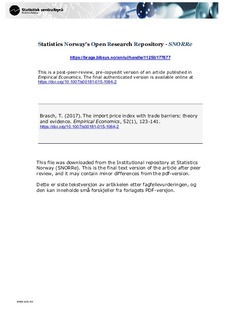| dc.contributor.author | Brasch, Thomas von | |
| dc.date.accessioned | 2019-01-14T15:53:41Z | |
| dc.date.available | 2019-01-14T15:53:41Z | |
| dc.date.issued | 2016-05-05 | |
| dc.identifier.citation | Brasch, T. von (2017). Empirical Economics, 52(1), 123-141. https://doi.org/10.1007/s00181-015-1064-2 | nb_NO |
| dc.identifier.issn | 1435-8921 | |
| dc.identifier.uri | http://hdl.handle.net/11250/2580562 | |
| dc.description.abstract | The standard economic import price index hinges on an assumption of free trade. Applying the index to situations with barriers to trade yields biased results compared to a true import price index. To circumvent this problem, it is common to use average prices, such as unit values, as an aggregator function. However, the use of average prices is not rooted in economic theory. In this paper, I generalise the economic import price index to allow for barriers to trade in the form of quantity constraints. To illustrate the theoretical framework, I use the case of imports of textiles to Norway from 1988 to 1997. I find that a standard economic import price index, such as the Laspeyres index, grossly overstates import costs and that this bias is significantly reduced by using unit values. | nb_NO |
| dc.language.iso | eng | nb_NO |
| dc.publisher | © Springer-Verlag Berlin Heidelberg 2016 | nb_NO |
| dc.subject | Import prices | nb_NO |
| dc.subject | Price level | nb_NO |
| dc.subject | Index numbers | nb_NO |
| dc.subject | Trade | nb_NO |
| dc.title | The import price index with trade barriers: theory and evidence | nb_NO |
| dc.type | Journal article | nb_NO |
| dc.type | Peer reviewed | nb_NO |
| dc.description.version | acceptedVersion | nb_NO |
| dc.rights.holder | © Springer-Verlag Berlin Heidelberg 2016 | nb_NO |
| dc.subject.nsi | VDP::Samfunnsvitenskap: 200::Økonomi: 210 | nb_NO |
| dc.source.pagenumber | 123-141 | nb_NO |
| dc.source.volume | 52 | nb_NO |
| dc.source.journal | Empirical Economics | nb_NO |
| dc.source.issue | 1 | nb_NO |
| dc.identifier.doi | https://doi.org/10.1007/s00181-015-1064-2 | |
